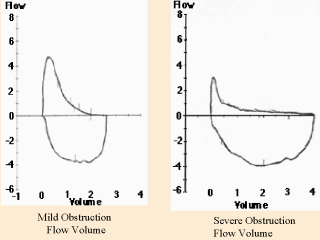 |
Obstructive
lung disease also changes the appearance of the flow volume curve. As with a normal
curve, there is a rapid peak expiratory flow, but the curve descends more quickly than
normal and takes on a concave shape, reflected by a marked decrease in the FEF25-75. With
more severe disease, the peak becomes sharper and the expiratory flow rate drops
precipitously. This results from dynamic airway collapse which occurs as diseased
conducting airways are more readily compressed during forced expiratory efforts. On the
volume time curve, this is seen as a slower ascent to maximum volume, with a gradual
upsloping versus the rapid rate seen in normal individuals. This equates with a prolonged
forced expiratory time demonstrable on physical exam. |
